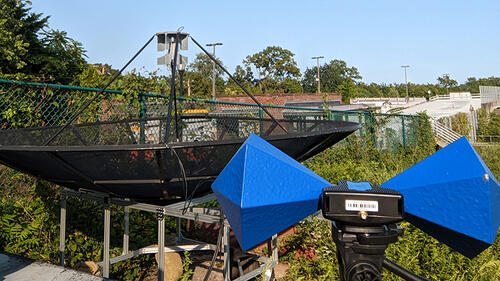
Wright Lab ‘s Will Tyndall, graduate student in physics, and other members from the research group of Laura Newburgh, assistant professor of physics and a member of Yale’s Wright Lab, have been developing a radio telescope that they can use as a testbed for instruments, technologies, and measurement techniques they are developing to calibrate telescopes at observatories around the world, including in the United States, Canada, Chile, and South Africa (please see our Research pages for more information on these experiments). The telescope is currently located on the roof of Wright Lab. In an E-mail interview, Tyndall explained further:
How did the project come about?
Our team is involved in research and development of techniques and equipment to map the beam shape of radio telescopes with a quadcopter drone. We needed a local radio telescope that we could use to develop our drone instrumentation and collect practice data before conducting calibration measurements at observatories around the world.
Developing our drone platform and all of its components here at Yale is much easier than doing all of our tests and measurements at a radio quiet site like Green Bank Observatory in West Virginia, although we have also done tests there, as well as at Brookhaven National Laboratory (BNL).
Michael Faison, the director of Yale’s Leitner Family Observatory and Planetarium (LFOP), had a few dishes on hand that were disused following Hurricane Sandy, and we knew that utilizing an existing dish that was already bought and paid for would be the easiest way to have a working testbed on a short timeline.
What is the purpose of the project? What is it a testbed for?
This telescope is extremely rudimentary, by scientific standards, but it is often easiest to start with the simplest case and add complexity later. For example, the instruments we are interested in calibrating with our drone have many dishes/elements that simultaneously collect data to produce interferometric measurements, while we are only using a single dish of modest size. However, our telescope is still sensitive enough to measure the signal we produce with our drone-based transmitter. So by performing a gridded flight above the beam of the telescope, we can measure the response of the telescope as a function of drone position, thereby producing a map of the telescope’s beam. This telescope has proved useful to verify our methods throughout the process of beam-mapping, and has given us some great insights that we have used on trips to observatories with more sophisticated instruments.
How long did it take / what were the dates you were working on the project?
Despite the relative simplicity, it took about a year to go from start to finish with the current version of the telescope after we were granted permission to use the existing 3 meter dish around spring of 2020.
The planning stage involved purchasing the ‘backend’ electronics and cables necessary for routing the signal from the dish and inside the building to a data acquisition computer I had built in the fall of 2019. We weren’t granted permission from Yale’s Environmental Health and Safety office (EHS) to create a permanent installation at LFOP for this telescope, and we were also restricted from accessing the roof of the building where the permanent mount for the 3m dish was located. So, in July of 2020, I constructed a wooden cart for transporting the dish out into the field, where drone measurements were more feasible. With this design, on days where we intended to fly the drone we could move the telescope into position for flights and then return it to a storage position so it would be out of the way afterwards.
In December of 2020, there was a really strong windstorm that destroyed the wooden cart and damaged the dish, so I redesigned the dish with aluminum components and outdoor-appropriate wheels. This was built and installed in March of 2021, and has held up ever since. This version has been relocated to the roof of the Wright Lab Connector.
Who else worked on the project with you, and what were their roles?
Yale physics undergraduate Ry Walker and former Yale Physics graduate student Emily Kuhn (now a NASA Postdoctoral Program fellow at NASA’s Jet Propulsion Laboratory) designed some of the electronics for the telescope. Former Yale physics postdoctoral associate Ben Saliwanchik (now a postdoc at BNL) and Emily helped on the day of the dish and cart assembly.
Yale undergraduates Maile Harris and Annie Polish helped at various times, as did Laura Newburgh, the PI of the project. I’m also super grateful to Michael Faison for allowing us to use the dish, and for Frank Lopez, research and development technician here at Wright Lab, for all of the help constructing the original wooden design and the logistics of connecting the telescope after relocating it to Wright Lab.
Were there any challenges you needed to overcome during the project, and, if so, please briefly explain what they were and how you found solutions.
Well, the weather destroying the first edition of the dish was not particularly helpful, but the redesign was worthwhile. Getting the data acquisiton computer to work, connecting it to the network at various places, and having reliable performance was always a bit of a battle, but it’s been extremely valuable to the project. Also the radio emission from nearby sources like broadcast TV and radio were extremely powerful and required the installation of some additional filters to observe the signal from the drone. Running the cables into Wright Lab was a bit of a task as well, but Frank orchestrated the whole thing and it ended up being pretty painless.
Photos
Photos of the telescope are available on our Flickr page here.
This story is taken from the Wright Lab News story of March 24, 2023 by Victoria Misenti.